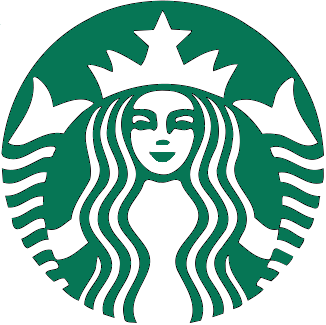On January 5, an update on the Starbucks Facebook page announced that the coffee company’s logo would be changing in the spring of 2011. The status update linked to a video message from CEO Howard Schultz on the Starbucks website in which he explained the reason for the change. An accompanying blog post said that the famous Siren needed the update in order to position the company “for future growth” as it explores new channels of distribution (think grocery stores).
As a quasi-traditionalist, I don’t always acclimate easily to institutional change – especially when it involves a sacred cow like my coffee. But I also understand that brands need to evolve in order to grow and enter new markets. The Starbucks logo introduced in 1992 – the one I’m reluctant to give up now – replaced the brown, vintage-looking Siren that decorated the first store Starbucks opened in Seattle’s Pike Place Market. I’m sure the original customers who discovered the coffeehouse before its explosive growth were reluctant to see that logo retired as well. But people are resilient and coffee habits die hard.
Brands change – they have to in order to survive – but that doesn’t mean change for change’s sake is necessarily a positive development. Remember New Coke or Gap’s recent logo fiasco? Starbucks is all about the experience they deliver for customers – from the store ambiance to the service. Oh, and of course the coffee. People pick Starbucks because they feel better about themselves after they leave the store, not because it’s better than Dunkin’ Donuts. If people start feeling different, they may go elsewhere. It remains to be seen whether people will acclimate to the new, modern logo and feel the same about their $4 latte. If the experience feels too institutionalized, Starbucks may lose its edge.
Starbucks’ handling of the switch doesn’t bode well for the direction of the company. As far as I can see, it hasn’t responded to a single comment on Facebook, despite hundreds of respectfully negative feedback on the new logo. If top management is as out of touch as the person managing the Facebook page, then the coffeehouse may be losing its bearings.
I certainly hope that’s not the case. After all, I’m dependent on their wi-fi internet and caffeine. But you can’t build a business model on wi-fi and jitters; I think my local McDonalds has wi-fi and lattes now. But they can’t beat the Starbucks experience. At least for now.

 As design director at Cookerly, Tim serves as the creative lead in the development of branding campaigns, print collateral and digital media for clients across a broad range of industries, including consumer, professional services, healthcare and technology.
As design director at Cookerly, Tim serves as the creative lead in the development of branding campaigns, print collateral and digital media for clients across a broad range of industries, including consumer, professional services, healthcare and technology. As a senior vice president at Cookerly, Mike Rieman is a strategic communications leader specializing in media relations and reputation management. With a proven track record of securing high-profile placements in top-tier outlets such as The New York Times, The Wall Street Journal, CNN and USA Today, he excels at crafting compelling narratives that resonate across print, broadcast and digital platforms.
As a senior vice president at Cookerly, Mike Rieman is a strategic communications leader specializing in media relations and reputation management. With a proven track record of securing high-profile placements in top-tier outlets such as The New York Times, The Wall Street Journal, CNN and USA Today, he excels at crafting compelling narratives that resonate across print, broadcast and digital platforms. Mike Touhill is vice president at Cookerly Public Relations, where he helps lead traditional, social and digital media programs for B2B and B2C clients in packaging, telecommunications and technology, among other industries. As a communication leader, he develops and executes public relations strategy, provides proactive and reactive counsel to C-level executives and secures earned media coverage for client initiatives and product.
Mike Touhill is vice president at Cookerly Public Relations, where he helps lead traditional, social and digital media programs for B2B and B2C clients in packaging, telecommunications and technology, among other industries. As a communication leader, he develops and executes public relations strategy, provides proactive and reactive counsel to C-level executives and secures earned media coverage for client initiatives and product. Andrew Agan is a vice president at Cookerly Public Relations, overseeing the agency’s internship program and leading media relations, content strategy and social media initiatives. He provides counsel and executes campaigns for clients across various sectors, including finance, healthcare, hospitality, technology, automotive and many others. Andrew excels at crafting compelling stories and building media relationships, resulting in clients being featured in notable outlets such as CNBC, Associated Press, Business Insider, Fox Business, HBO, Inc. Magazine, Sirius XM, The Wall Street Journal and USA Today, among others.
Andrew Agan is a vice president at Cookerly Public Relations, overseeing the agency’s internship program and leading media relations, content strategy and social media initiatives. He provides counsel and executes campaigns for clients across various sectors, including finance, healthcare, hospitality, technology, automotive and many others. Andrew excels at crafting compelling stories and building media relationships, resulting in clients being featured in notable outlets such as CNBC, Associated Press, Business Insider, Fox Business, HBO, Inc. Magazine, Sirius XM, The Wall Street Journal and USA Today, among others.


 As vice president of Cookerly, Sheryl Sellaway uses her extensive corporate communications background to lead consumer PR efforts, deliver strategy for marketing programs and share expertise about community initiatives.
As vice president of Cookerly, Sheryl Sellaway uses her extensive corporate communications background to lead consumer PR efforts, deliver strategy for marketing programs and share expertise about community initiatives.